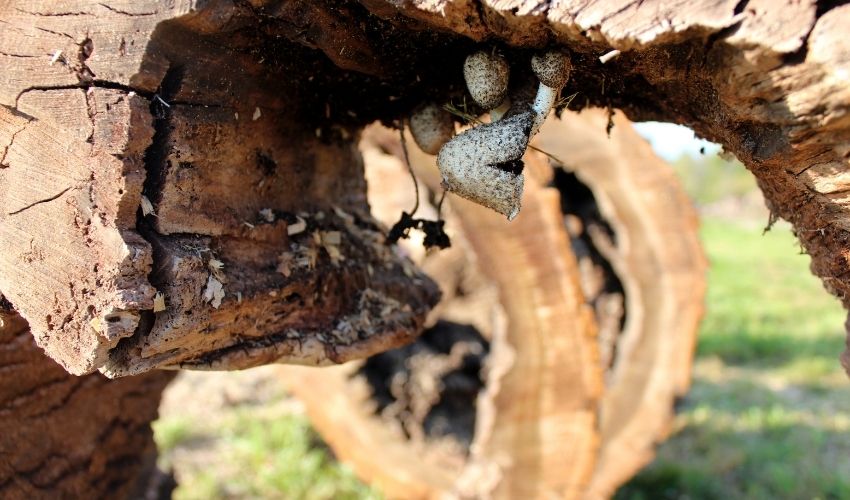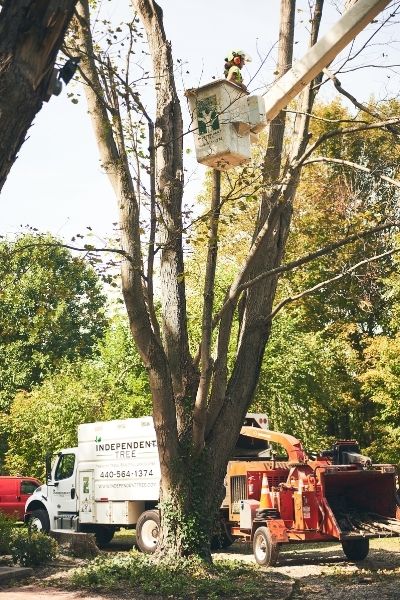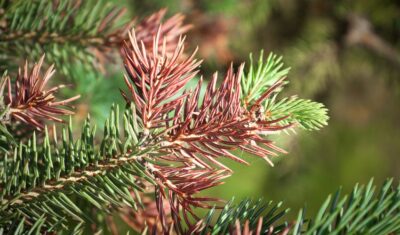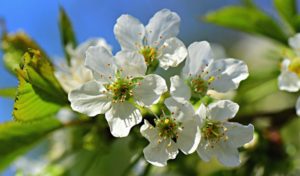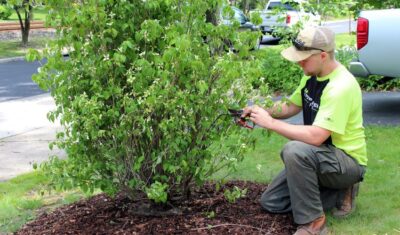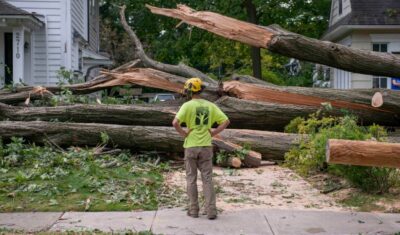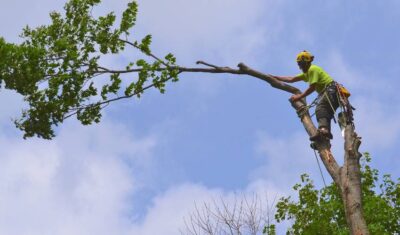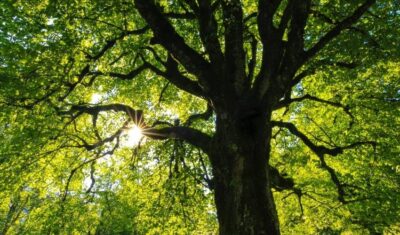The words “tree rot” or “your tree is decaying” can strike fear in the heart of any northern Ohio property owner. Does it mean your tree is dying? Will a tree with decay need to be cut down? Does tree rot make the tree dangerous to the property and people around it?
Once tree rot has started, it’s difficult to stop. However, decay in healthy trees can sometimes be stopped from spreading and even prevented entirely – but only if it’s caught early. That’s why it’s vital to know the signs of decay in trees, as well as how to properly care for your trees to minimize the risk of tree decay.
In this article, we cover:
- the types of rot that can affect trees in northeast Ohio,
- how to tell if a tree is decaying, including the tell-tale signs to look for,
- simple tips to prevent tree decay issues,
- whether tree rot and decay can be treated, and
- how to know when a decaying tree should be cut down.
➔If you’re worried that your tree might fall due to decay or rot, contact Independent Tree now to prevent costly damage or injuries.
What is Tree Decay?
Tree decay, or tree rot, is the process of decomposition of the wood (lignin and cellulose) in a tree. It can begin in the sapwood, the heartwood, or the roots, depending on the type.
Tree decay is caused by a variety of wood-decay fungi. The pathogen usually enters the tree through a wound that damages the protective bark. Lawncare equipment, birds (such as woodpeckers), improper pruning, boring insects (like Emerald Ash Borer), and storm damage are typical causes of decay-causing tree wounds.
Types of Tree Decay
Some of the most common kinds of tree rot include:
- White rot – White rot breaks down the lignin of a tree, the substance responsible for the strength of the wood. You might see the tree with a bulge on the trunk since it can no longer stand up under its weight. White rots are mostly found on broadleaf trees and leave the tree feeling spongy with a white or yellow tint.
- Soft rot – Soft rot usually infects broadleaf trees. However, it typically only infects softwood that has already started to decay.
- Heart rot – Heart rot affects the normally protected heartwood of the tree. It has to gain entry through a wound in the tree (which is one reason why you need to take such care when pruning).
- Sap rot – Sap rot often comes in through dead wood or as a secondary fungal invasion. Sap rot progresses quickly and will cause significant structural failures.
- Brown rot – Brown rot primarily affects coniferous trees. First, the wood will appear brittle and dark brown. Eventually, it will shrink and break into cubes. Brown rots make trees much more vulnerable to high winds.
- Butt rot – Butt rot is characterized by decay that moves up through the tree from the roots into the tree’s body.
- Root rot – Root rot enters through root grafting on a tree and will cause dieback in the roots or take away their ability to take up nutrients. Eventually, that will cause crown dieback and tree death.
How Can You Tell If a Tree is Decaying?
Tree rot in a living tree isn’t always apparent. However, there will often be signs that indicate its presence and give clues about the type(s) of tree rot that could be involved.
Signs of Tree Decay
Decay usually starts with some sort of wound to the tree, so be on the lookout for signs of damage. Beyond that, the top signs of a decaying tree trunk, or any other part of the tree for that matter, include:
- Holes or cracks in the bark
- Dead sections of the trunk or branches
- Leaf issues (such as discoloration, dieback, spotting, sparse leaf cover)
- Mushrooms or other fungi on the trunk, root flare, or ground around the tree
- Wounds to the bark or wood (these are often caused by poor pruning cuts, broken branches, and yard tools such as string trimmers)
- Holes in the bark caused by pests, such as sapsuckers, borers, or rodents
- Evidence that the tree is beginning to lean, such as soil cracking or heaving up on one side of the tree or roots pulling out of the ground
- Sawdust around the base of the tree (usually caused by insects boring beneath the bark)
- Root damage
- Soft sections on the tree or oozing areas
- Crumbling or peeling bark
- Cavities forming beneath the bark
Not all these signs will be present when a tree is decaying. Many also indicate that the tree has other problems, such as an insect infestation or lack of nutrients. So, don’t take this list as a complete checklist of tree decay symptoms or a surefire sign that your tree is rotting.
Some of these signs show you an opportunity for better tree care. For example, holes from pests will tell you what to treat for in the future. Issues with the leaves can point to specific tree diseases and infections. In some cases, these are reversible and may only require certain fertilizers if it is a deficiency-related disease.
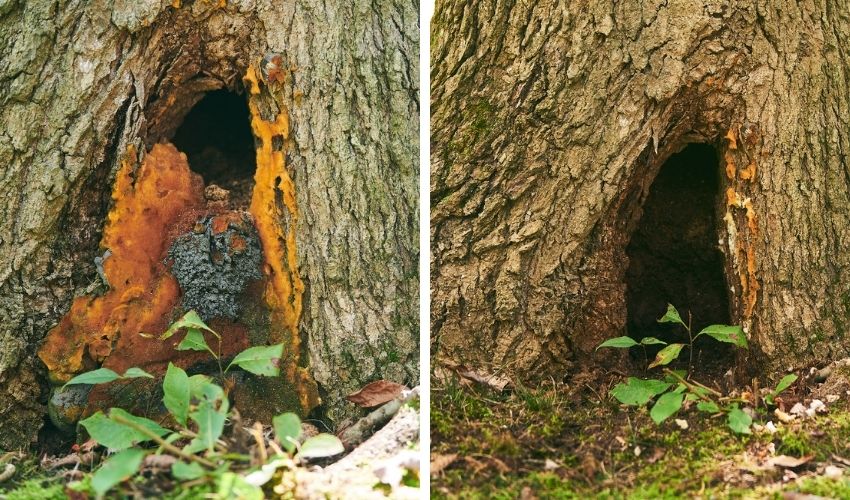
Spray foam was used by a property owner (left image) in an attempt to seal up this tree wound. Independent Tree does not recommend the use of spray foam and it was removed and the wound cleaned (right image)
If I Notice These Signs, Is My Tree Dying?
Signs of decay don’t automatically mean that your tree is dying! Some of these symptoms are treatable issues. In other cases, the tree may be able to stop the spread of decay itself.
However, some of the symptoms do indicate that you need to remove the tree. For example, a tree that’s leaning toward your house or one with significant root damage should probably be removed.
Whatever the case might be, don’t jump to conclusions. You won’t have a definitive answer until a Certified Arborist has examined the tree.
Dangers of Tree Decay
Decay can cause a variety of mechanical issues inside a tree. It limits the way the tree can function by breaking down the strength of the wood or impeding the uptake of nutrients.
The biggest danger of a decaying tree is that it, or part of it, will fall on people or property nearby. Sadly, signs of significant internal decay are often invisible from the outside or hidden underground. As a result, trees can suddenly break apart or fall with no warning.
That is why getting a Certified Arborist to inspect your tree is essential. An arborist will closely examine the tree for signs of decay, including a visual inspection, probing to find hidden decay, or possibly using specialized tools to visualize the interior of the tree. If your tree is at high risk of failure, an arborist will be able to recommend the best way to deal with it.
PRO TIP – Look for an arborist who has a Tree Risk Assessment Qualification from the International Society of Arboriculture. These arborists are specially trained to identify, evaluate, and mitigate risk in trees.
How to Prevent Tree Rot
Prevention is the best treatment for trees. While there’s no way to completely prevent the possibility of decay, there are many things you can do to minimize the chances of it happening and/or fatally damaging your tree.
Inspect Your Trees Regularly
You can start by getting annual inspections done on all of your trees. This will help you identify any issues as early as possible before they become a serious and untreatable problem. Then, the arborist can offer suggestions for the best way to manage the tree to keep it as healthy as possible.
Follow a Plant Health Care (PHC) Program
We highly recommend a Plant Health Care (PHC) maintenance program for your trees. These programs are customized to meet the unique needs of your trees and include regular inspections to identify early signs of tree pests, diseases, and decay. This allows you to treat them early and prevent further spread.
Avoid Wounding Your Trees
While you maintain the rest of your yard, be aware of the placement of your equipment, such as lawnmowers and string trimmers. Keep them away from your trees, so you don’t create more damaging wounds.
Diseased wounds are frequently caused by poor pruning. Use proper pruning practices or have your pruning done by a Certified Arborist.
Fertilize & Water Trees as Needed
Soil in urban and suburban areas throughout northeast Ohio tends to be compacted and depleted of most of the essential nutrients trees need to thrive. Fertilizing your trees rebuilds the soil and provides vital nutrients to help keep them healthy so they are more effective at fighting off pests, diseases, and decay.
Similarly, trees need adequate water to help them grow and fend off threats. Be sure to water up to the drip line which extends as far out as the tree’s canopy. Also start watering several feet from the tree’s trunk. This ensures that the entire root system is receiving the water it needs to grow and expand (a tree’s roots are not right around the trunk so watering there has little, if any, effect).
A stressed tree is more vulnerable to infection by tree rot pathogens and less able to defend itself. Watering and appropriate fertilization will help alleviate stress.
How Trees Defend Themselves Against Decay
A healthy tree’s natural defense system is quite effective at preventing internal decay or disease from spreading to other parts of the tree.
The primary defense of the tree against decay is compartmentalization. Trees can seal off damaged parts of the tree, blocking access to the rest of the tree. That way, if decay gets into the injured part of the tree, it can’t move through the tubes that carry water and nutrients into other parts of the tree.
When a tree is wounded, it doesn’t “heal”; instead, the tree seals off the wounded part. However, if the wound is too big, the tree can end up killing itself by sealing it off and massively restricting its nutrient and water flow. Similarly, if the wound or decay is in the main tree trunk, the tree may not be able to seal it off without killing the upper parts of the tree. In those cases, it will be almost impossible to stop the spread of decay.
How to Treat Decaying Trees
Unfortunately, once tree rot gets a foothold in the tree, it is challenging to stop it and save the tree.
There are few straightforward answers for how to treat a tree with decay since the best treatment depends on the cause of the decay, its extent, and sometimes, the type of tree.
- Depending on what part of the tree gets wounded, an arborist might be able to use preventative pruning to eliminate the source of decay (such as a branch).
- If the tree is healthy and rot hasn’t spread far, the tree may be able to heal itself.
- Fertilization and proper watering (as part of a complete Plant Health Care program) may help improve the tree’s health and extend its life, even if it has signs of decay (as long as it’s not at risk of falling!).
- In some cases decay management fungicides can prolong the life of the tree.
Some things NOT to do are:
- Trying to cut out the affected part of the trunk or roots
- Paint over the wounded, rotting area
- Scraping out the inside of a cavity caused by tree rot
- Filling the cavity with concrete or spray foam
All of these will make the problem worse and doom your tree to an even earlier death.
Get Help from Certified Arborists
If you are worried about trees on your property that might be suffering from decay, you can use the help of a Certified Arborist.
It is also essential to keep in mind that trees only have a finite lifespan. Eventually, they will end up decaying as a part of their natural lifecycle. As long as you remove the dead tree in a timely manner, they won’t put your property or any person at risk.
Tree rot is dangerous, but we have the training and the skill to help you with a tree decay evaluation. Independent Tree is proud to have several arborists on staff with the Tree Risk Assessment Qualification. You can be sure you’re getting a comprehensive and accurate evaluation, as well as reasonable and actionable recommendations, from our highly qualified arborists. We can also guide you on planting any new trees if you have to take the decayed tree down.
In the end, proper care and maintenance of your trees will do the most in helping them live a longer, fuller life.
Schedule a Property Inspection
An arborist will closely examine the tree for signs of decay, including a visual inspection, probing to find hidden decay, or possibly using specialized tools to visualize the interior of the tree. If your tree is at high risk of failure, an arborist will be able to recommend the best way to deal with it.Recent Articles
Topics
About The Author

STAY IN THE LOOP
WITH OUR
LATEST UPDATES
"*" indicates required fields

